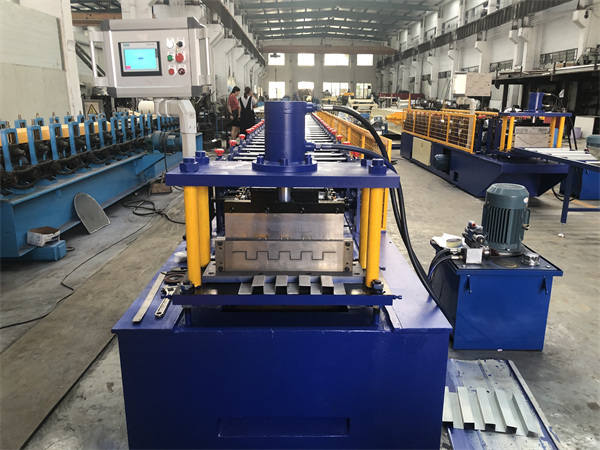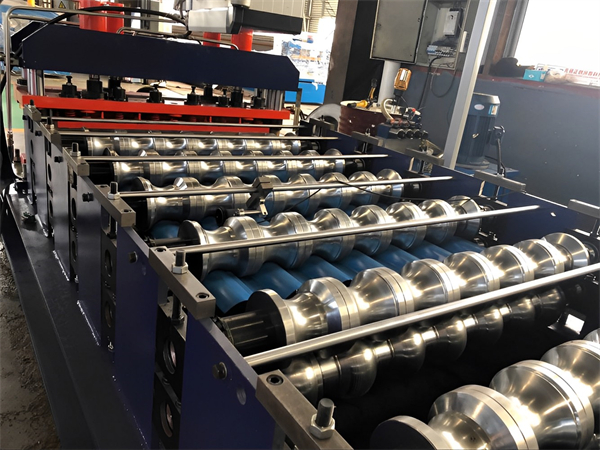Truss roll forming machines are essential equipment for manufacturing metal trusses efficiently. This guide provides a detailed overview of truss roll forming machine types, main components, specifications, applications, installation, operation and maintenance. It also includes tips for choosing suppliers, cost considerations, and pros and cons of different truss roll forming systems.
Gambaran Umum Mesin Pembentuk Rangka Gulungan Truss
Roll forming is a continuous bending operation in which sheet or coil steel is progressively shaped as it passes through consecutive sets of rollers until the desired cross-sectional profile is obtained. Roll formed sections have high dimensional accuracy and consistency.
Truss roll forming machines are designed specifically to produce metal trusses used extensively in construction, usually with triangular webs and chord sections. The automated roll forming process allows mass production of trusses in a variety of configurations, sizes and materials.
The main advantages of truss roll forming are:
- Highly efficient process with low labor requirements
- Kualitas dan akurasi dimensi yang konsisten
- Minimal scrap loss compared to other truss fabrication methods
- Flexible production of different truss designs and sizes
- Relatively low equipment cost compared to other automated options
The limitations are lower line speed versus other processes, and limited to long, straight truss sections. Materials commonly used are galvanized steel, stainless steel and aluminum.
Truss Roll Forming Machine Types
There are two main types of truss roll forming machines:
Pembentuk Gulungan Standar
- Produce single-web trusses with C or U-shaped chord sections
- Fixed forming stations with common top and bottom roll sets
- Manual or powered section feeding
- Simplest and most economical option
Gantry Roll Forming Systems
- Produce multi-web trusses with complex web and chord shapes
- Roll stations mounted on moving gantry above section
- Automated section feeding from coil
- Provide most flexibility for profile designs
Main Components of Truss Roll Forming Machines
Truss roll forming machines typically consist of the following main components:
| Komponen | Keterangan |
|---|---|
| Uncoiler | Feeds raw coil stock into line at constant tension |
| Feed tables | Support and guide sheet through inline stations |
| Stasiun pembentuk | Contain top and bottom roll sets that gradually shape the profile |
| Unit pelubang kertas | Punch holes in web and chord sections |
| Perangkat geser | Cuts sections to length at production speed |
| Sistem pengaturan | Controls roll sets and material feed |
| Konveyor/penumpuk | Catches and stacks finished trusses |
Additional secondary components like decoilers, levelers, notching presses etc. may be integrated into the line per application requirements.

Truss Roll Forming Machine Specifications
Truss roll forming machines vary widely in production speed, size capabilities and other parameters based on the design and budget. Typical specifications are outlined below:
| Spesifikasi | Jangkauan |
|---|---|
| Kecepatan garis | 16 – 164 feet/min |
| Web depth capacity | 4 – 24 in |
| Chord thickness | 18 ga – 3/16 in |
| Melubangi lubang | 1/4 – 3/4 in diameter |
| Jarak lubang | 6 – 12 in |
| Hole pattern | Triangular or rectangular |
| Toleransi panjang | +/- 1/16 in |
| Bobot | 6,000 – 60,000 lbs |
| Panjang | 30 – 300 ft |
Higher end gantry type truss roll forming machines can accommodate depths up to 5 feet and thicknesses up to 5/16 inches. They can also punch oversize holes up to 2 inches for utility access. The maximum single section length depends on the layout but can reach up to 60 feet.
Choosing Truss Roll Forming Machines
The main factors to consider when selecting a truss roll forming machine are:
- Required truss specifications – web depth, chord thickness, hole size/pattern etc.
- Volume produksi – impacts line speed, number of forming stations etc.
- Anggaran – standard roll formers are most economical
- Flexibility for future designs – gantry systems offer most versatility
- Jenis bahan – galvanized steel, stainless or aluminum
- Keterbatasan ruang – length, height and layout requirements
- Tingkat otomatisasi – manual vs. powered material handling
- Integration with other processes – cut-off, stacker, LVL line etc.
Work closely with truss roll forming machine manufacturers to determine the best solution matching your production needs and budget constraints.
Applications and Uses of Truss Roll Forming Machines
Truss roll forming is commonly used to manufacture:
- Metal plate web trusses for roofs and floors
- Lattice girders for bridges and towers
- Triangular web joists as an alternative to wood trusses
- Industrial storage racks, platforms, mezzanines
- Scaffolding structures
- Agricultural and aviation hangars
- Mining infrastructure
- Stadiums and large industrial buildings
Any application requiring repetitive structural triangular truss frames and braces are well suited for automated roll forming production.
Advantages of Truss Roll Forming Machines
Key benefits of using roll forming to fabricate metal trusses:
- Produktivitas tinggi – capable of producing over 5,000 feet per shift
- Kualitas yang konsisten – eliminates human error in fabrication
- Lower labor costs – operates with 1-2 workers only
- Penghematan material – less scrap vs. cutting individual truss parts
- Fleksibilitas – fast changeovers between designs and sizes
- Ukuran yang ringkas – reduces factory space requirements
- Keamanan – minimal direct human involvement avoids injuries
For high volume truss requirements, roll forming is the preferred manufacturing process.

Limitations of Truss Roll Forming Machines
The main limitations are:
- Biaya awal yang tinggi – gantry systems can cost over $500,000
- Fixed sizes – changes require mechanical reconfiguration
- Straight sections only – cannot produce angles or curves
- Lower speeds – max 164 ft/min versus other methods
- Large space – machines may occupy over 300 feet
- Specialized skill – technicians required for setup and maintenance
Roll forming is most cost-effective at over 100,000 feet of production per year.
Installation and Setup of Truss Roll Forming Equipment
Proper installation and setup is key to achieving specified tolerances and performance. Below are general guidelines:
- Foundation must be flat and level – use jack bolts to make precise adjustments
- Infeed and outfeed tables must be perfectly inline with roll stations
- Roll sets should be independently adjustable for precision alignment
- Test run initial pieces and make any position adjustments
- Perform first full production run and check key dimensions
- Make any necessary forming pressure or feed rate changes
- Re-tighten all bolts after initial operation
- Schedule preventive maintenance every 6 months
Work closely with the machine manufacturer’s technicians for the initial installation and setup.
Operation and Maintenance of Truss Roll Forming Machines
Day-to-day operation guidelines include:
- Inspect raw material – verify within thickness tolerance
- Monitor stations for overheating – adjust pressure as needed
- Randomly check key dimensions – web depth, chord width etc.
- Watch for deformations or cracking – stop immediately if observed
- Clean equipment of metal dust buildup weekly
- Lubricate bearings, gears and rollers as specified
- Inspect electrical, hydraulics and pneumatics routinely
- Melakukan pemeliharaan preventif sesuai jadwal
For maximum productivity and part quality, follow the equipment manufacturer’s detailed operating and maintenance procedures.
Tips for Choosing a Truss Roll Forming Machine Supplier
Here are key factors in selecting a truss roll forming machine supplier:
- Experience designing and building the required capacity and features
- Offer equipment within your budget constraints
- Have installed similar lines in your geographic area
- Provide turnkey services – design, fabrication, installation
- Have in-house engineering staff for development
- Offer flexible purchasing options – buy, lease, rent
- Can provide references from existing customers
- Provide training on operation and maintenance
- Have regional presence for service and support
- Offer upgrades and capability expansion options
Taking the time to thoroughly evaluate suppliers using these criteria will help pick the right partner for your long-term needs.
Truss Roll Forming Machine Cost Considerations
Truss roll forming equipment represents a major capital investment. Key factors impacting cost include:
| Faktor | Dampak Biaya |
|---|---|
| Kecepatan garis | Faster speeds increase cost |
| Panjang garis | Longer lines cost more |
| Tingkat otomatisasi | More automation increases price |
| Gantry vs. fixed stations | Gantry machines cost substantially more |
| Capacity – depth, thickness | Higher capacities increase cost |
| Pemrosesan tambahan | Integration of punching, notching etc. add cost |
| Kontrol | More advanced controls add cost |
| Service packages | Installation, training etc. services add cost |
Ballpark investment ranges:
- Manual roll former: $75,000 – $150,000
- Standard automated: $150,000 – $350,000
- Gantry system: $300,000 – $1,000,000
Getting multiple quotes from several suppliers is advised to get the best value.

Pros and Cons of Truss Roll Forming Machines
| Kelebihan | Kekurangan |
|---|---|
| Fast, efficient, high volume production | High initial equipment cost |
| Consistent and accurate | Inflexible for design changes |
| Minimal scrap and material waste | Limited to straight sections |
| automated process needs few workers | Require large factory space |
| Flexible for different specifications | Complex maintenance requirements |
| Compact compared to other methods | Significant long term investment |
FAQ
Below are answers to some common questions about truss roll formers:
Q: What types of trusses can be produced on roll forming machines?
A: Most standard truss designs with triangular webs and C/U channel chords up to 24″ deep can be roll formed. Gantry machines can produce more complex or custom truss and joist shapes.
Q: What are the ideal production volumes for roll formed trusses?
A: Roll forming is optimized for high volumes, typically over 100,000 linear feet per year to justify the equipment investment. It is less suited for small batch or custom truss production.
Q: How quickly can truss roll forming machines be changed over to new designs?
A: On fixed station machines, it may take 8-12 hours to change over roll sets and tooling. On gantry machines with quick-change tooling, set up may take only 1-2 hours.
Q: What expertise is required to operate truss roll forming equipment?
A: The equipment can be run with 1-2 semi-skilled operators per shift. Mechanics are needed for maintenance and roll changes. Programming knowledge is required for the control system.
Q: What safety measures are required for truss roll forming machines?
A: Equipment should be fully enclosed with interlocks on doors. Workers should wear protective gear. Additional safety measures may be needed per local regulations.
Q: Can other processing like punching be integrated into the truss roll forming line?
A: Yes, punching units for web holes and notching presses for service cutouts can be integrated in a single automated production line.
Q: Can truss roll forming machines produce curved or angled trusses?
A: No, roll forming is limited to straight or planar truss sections only. For curved profiles, other processes like break press are required.
Q: What factors determine the maximum production speed of truss roll forming machines?
A: The overall line speed depends on uncoiler capacity, number of stations, material thickness, hole punch time, and desired quality level. More stations or thicker material require slower forming speeds.
Kesimpulan
Truss roll forming machines offer an efficient automated process to mass produce metal truss framing for construction projects. Their advantages in productivity, quality and cost make them a popular fabrication method for high volume requirements. Carefully selecting the right equipment based on production needs and working closely with suppliers will ensure successful implementation. Proper installation, operation and maintenance procedures must be followed to optimize performance.
